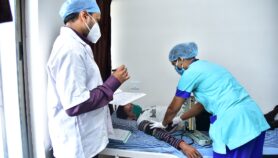By: Colin Mathers
Send to a friend
The details you provide on this page will not be used to send unsolicited email, and will not be sold to a 3rd party. See privacy policy.
We need better global monitoring for chronic diseases before we can really tackle the risks factors and prevent illness, says Colin Mathers.
The balance between infectious and non-communicable diseases is shifting. The WHO predicts leading infectious diseases will soon kill fewer people globally, and by 2030, three-quarters of all deaths in the world will be due to chronic non-communicable diseases like heart disease and some cancers.
Close to 50 per cent of people dying from chronic diseases in low- and middle-income countries are under 70 years old, compared to only 27 per cent in high-income countries. As populations grow and people live longer, the numbers of chronic disease deaths in these countries will substantially increase. Over the next 25 years, the global distribution of deaths will shift from younger to older ages.
The problem is that the WHO predictions are based on limited data that are insufficient for a global strategy to tackle chronic diseases. Many developing countries have inadequate surveillance systems for chronic diseases and their risk factors, so the statistical information we need to monitor trends in disease and death from such illnesses is fragmentary. What we need is sustained and continuous monitoring of trends in chronic diseases and their determinants in developing countries.
Inadequate information
Only about a third of the world’s population is covered by national death registration systems. The coverage is over 95 per cent in Europe, but it is lower than five per cent in Africa. While population surveys provide a lot of information on child mortality in Africa and Asia, comparatively little is known about levels of adult mortality. This partly reflects efforts to address very high levels of child mortality in poor countriesand partly the problems of accurately surveying adult mortality.
WHO estimates suggest that the risk of dying from chronic diseases is generally higher in Africa and Asia, and other middle-income countries, than in high-income countries. But the data cannot generally be used to monitor trends over timebecause of changing methods and data quality. The WHO and the Health Metrics Network have both prioritised extending and improving national death registration systems, and improving the methods used to identify causes of death. The low priority many developing countries give to preventing chronic disease is partly due to the lack of good data on death rates from such illnesses. Many health policy makers do not realise that chronic diseases are already responsible for almost three-quarters of deaths in middle-income countries.
Disease registers and epidemiological studies are important sources of information, but problems of comparability often limit their use for monitoring trends. For example, it can be difficult to assess whether more people dying from stroke reflects true changes over time or differences in study design and types of cases sampled. The International Agency for Cancer Research has estimated regional and global incidence for most types of cancers but the last available estimates are for 2002. Almost no information on trends in incidence or survival rates is available. The most common cause of death in the world is coronary heart disease but there are very few recent population-level studies of its incidence or prevalence in low- and middle- income countries.
Known risks
More detailed information is available about risk factors for chronic disease. The WHO Global Infobase has assembled population-level survey data for eight important chronic disease risk factors. The WHO has also prepared comparable country level estimates and projections for several of these. For example, recent survey data on tobacco smoking in adults is available for more than 130 countries, and recent information on numbers of overweight and obese adults for around 150 countries.
Using these and other data, the WHO estimates that over 70 per cent of cardiovascular disease deaths and around 50 per cent of all chronic disease deaths are attributable to a small number of risk factors. Four of the most important risks are unhealthy diet, physical inactivity, tobacco use and high blood pressure. Globally, these factors are increasing as people switch to foods high in fats, salt and sugars, while their work and living situations make them much less physically active. The number of people who are overweight or obese will rise from one billion currently to more than 1.5 billion by 2015 if current trends continue. Tobacco use is also increasing in low-income and middle-income countries.
High-income countries have cut death rates from chronic diseases over recent decades even though levels of overweight and obesity, and physical inactivity, have worsened. This is probably because smoking is falling and factors such as high blood pressure and high blood cholesterol are better controlled. Treatments for the diseases themselves have also improved. If economic development in low- and middle-income countries does not result in similar improvements, their burden of non-communicable diseases may increase even faster than projected by the WHO.
Prevention better than cure
Preliminary research into preventing chronic diseases is encouraging. Scientists, publishing in The Lancet in December 2007, found that widespread efforts to curb salt intake and smoking, and to ensure those at risk of heart disease take needed drugs, could prevent millions of deaths each year in developing countries. Reducing salt intake by 15 per cent and controlling tobacco use, for example by raising taxes, enforcing smoke-free workplaces and raising public awareness, would prevent nearly 14 million deaths over 10 years in low- to middle-income countries at a cost of less than 40 cents per person. Identifying and treating people at high risk of heart disease in these same countries could avert nearly 18 million deaths in 10 years, through a daily regimen of aspirin, two common blood pressure pills and a cholesterol-lowering drug.
There are global strategies, such as the WHO Framework Convention on Tobacco Control and the WHO Global Strategy on Diet, Physical Activity and Health, to help developing countries tackle the key risk factors. These global strategies can provide a framework for developing and implementing national prevention and control strategies for chronic diseases.
As chronic diseases become more important for developing countries, so does the responsibility for measuring disease causes and trends, and assessing efforts to combat them. The developing world needs stronger national capacities for gathering high-quality primary data. Countries need to invest in software and hardware platforms as well as in human resources and institutional systems. Initiatives such as the Health Metrics Network provide an opportunity for developing countries to improve their health information systems by working together with technical agencies.
We also need strengthened international capacity to synthesise data on chronic diseases and improve monitoring for international trends for mortality, disease incidence and risk factors. The new Global Burden of Disease study being carried out by a consortium of institutions, including the WHO, and funded by the Bill and Melinda Gates Foundation, will aim to estimate trends in chronic disease burden from 1990 to 2005 for all regions of the world. This study will publish results for 21 regions of the world in 2010. It will provide an important resource for developing countries who also wish to conduct national or regional analyses to help set their own health priorities.
Colin Mathers is a senior scientist at the Department of Measurement and Health Information Systems, World Health Organization, Geneva, Switzerland.
This article is part of a Spotlight on Tackling chronic diseases.
More on Capacity building

Script media release
Journalists offered ‘big break’ mentoring opportunity from Radio Nigeria
03/04/19












